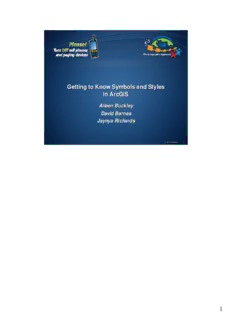
Getting to Know Symbols and Styles in ArcGIS PDF
Preview Getting to Know Symbols and Styles in ArcGIS
GGeettttiinngg ttoo KKnnooww SSyymmbboollss aanndd SSttyylleess iinn AArrccGGIISS AAiilleeeenn BBuucckklleeyy DDaavviidd BBaarrnneess JJaayynnyyaa RRiicchhaarrddss UUCC 22000077 TTeecchh SSeessssiioonnss 11 1 AAggeennddaa ••UUnnddeerrssttaannddiinngg ssyymmbboollss iinn AArrccGGIISS ––HHooww ssyymmbboollss aarree ddeeffiinneedd ––HHooww ttoo ddeessiiggnn ffoorr ssppeeeedd aanndd qquuaalliittyy ••UUnnddeerrssttaannddiinngg ssttyylleess iinn AArrccGGIISS ––SSttyyllee MMaannaaggeerr ––UUssiinngg SSttyylleess ttoo mmaakkee aa wweellll bbeehhaavveedd mmaapp ––EExxppoorrttiinngg ssttyylleess UUCC 22000077 TTeecchh SSeessssiioonnss 22 In this session, our goal is to explain how symbols and styles work so that you have greater control over map design and more efficiency in map production. We’ll explain how symbols are created and managed in ArcGIS and we’ll give you tips that can be used to work with them more efficiently. Then we’ll show you some tricks for working with styles. This will help you understand how proper management of symbols and styles can help you make what we call a “well-behaved map”. 2 mmaappppiinnggcceenntteerr..eessrrii..ccoomm UUCC 22000077 TTeecchh SSeessssiioonnss 33 Before we get started, I just want to point out that this presentation with all the notes about what we re saying will be posted on the Mapping Center web site – a new addition to the ESRI Support Site that offers all sorts of resources related to mapping – including our presentations. We will post this for your there so you don't have to take copious notes about this presentation. 3 CCaarrttooggrraapphhyy 110011 ••““SSyymmbbooll”” oonn aa mmaapp == ggrraapphhiicc ssiiggnn eennddoowweedd wwiitthh ggeeooggrraapphhiiccaall mmeeaanniinngg ••““GGrraapphhiicc mmaarrkkss”” == tthhee bbaassiicc ggrraapphhiicc eelleemmeennttss oonn aa mmaapp:: ppooiinnttss,, lliinneess,, ppoollyyggoonnss,, ppiixxeellss,, tteexxtt ••““VViissuuaall vvaarriiaabbllee”” == tthhee vviissuuaall cchhaarraacctteerriissttiiccss ooff tthhee ggrraapphhiicc mmaarrkkss tthhaatt ccaann bbee rreellaatteedd ttoo aattttrriibbuutteess UUCC 22000077 TTeecchh SSeessssiioonnss 44 Let’s start with a few basics about symbols in map making. Symbols are signs on maps that carry geographical meaning to the map reader. They are assigned to what cartographers call “graphic marks” – a GIS user will think of these as the basic points, lines and polygons on the map that you apply symbology to. Don’t forget that text is a symbol on a map as well, and rasters can also be symbolized. 4 TTaabbllee 66..22 iinn DDeessiiggnniinngg BBeetttteerr MMaappss CCyynntthhiiaa BBrreewweerr,, 22000066,, EESSRRII PPrreessss UUCC 22000077 TTeecchh SSeessssiioonnss 55 Cindy Brewer shares some really nice graphic examples of the visual variables in her book, Designing Better Maps. She also explains about these in more detail so we won’t go into it in this session. 5 EExxaammppllee CCaarriibbbbeeaann SSeeaa MMaapp UUCC 22000077 TTeecchh SSeessssiioonnss 66 Let’s take a look at some examples of how geographic data are symbolized in a map that David Barnes, our demo guy here, has made. For this we will tour a map of the Caribbean Sea that was compiled to look like a historical map. 6 UUCC 22000077 TTeecchh SSeessssiioonnss 77 Note on this map that we have some special point, line, and polygon symbols. We also have some wonderful text. Hillsigns The hills, for example, are symbolized using what cartographers call “hillsigns”– pictographic symbols that look a bit like the features they symbolize. These are actually marker symbols that have been applied to different classes of physiographic features, such as hills, mountains and mountain ranges. Rhumb lines For lines, we can take a look at the “rhumb lines”, or lines of constant direction. David digitized these using the compass roses to connect lines that have the same bearing. These are simple line symbols which we will talk more about soon. Coastal rakes David also used some special line pattern fills for some symbology. For polygons, we can see that the area along the coasts have been given a special treatment to emphasize the land-water interface. This technique is a variation on the coastal vignettes that we have shown in the past –these are called coastal rakes and they were created by assigning the different buffers with the line pattern fills. Ocean art David also did some clever things with marker symbols to add ocean art to the map –notice the little ships and sea serpents in the water areas. Type And finally, note some of the wonderful things that he did with type –like labels for the Caribbean Sea and other water bodies, as well as the informationin the cartouche at the top right. 7 SSyymmbboollss iinn tthhee ssooffttwwaarree ••MMaapp ccoonntteennttss tthhaatt uussee ssyymmbboollss ––GGeeooggrraapphhiicc ffeeaattuurreess ––MMaapp eelleemmeennttss ––GGrraapphhiiccss ••BBuuiilldd,, eeddiitt aanndd ssaavvee yyoouurr oowwnn ssyymmbboollss ••BBuuiillddiinngg bblloocckkss ooff ssyymmbboollss UUCC 22000077 TTeecchh SSeessssiioonnss 88 So, you can see that you can achieve some neat symbology with the software. But before we take you into the symbol design interface where you can create these, we want to explore some of the fundamentals about symbology in ArcGIS. Let’s start with the basics: Symbols are used not only to draw geographic features, but also to display the various map elements, such as legends, scale bars and north arrows, as well as any graphics you may add to the map, such as bounding boxes or lines that divide the space on your page layout. Because they are used so extensively, you may sometimes want to create your own symbols. Before you do this, it would be helpful to understand the basic building blocks of symbols. 8 BBuuiillddiinngg bblloocckkss ooff ssyymmbboollss ••CCoolloorrss ••FFoonnttss ••GGrraapphhiicc ffiilleess ••DDooeess nnoott iinncclluuddee 33DD ssyymmbboollss oorr ccaarrttooggrraapphhiicc rreepprreesseennttaattiioonnss UUCC 22000077 TTeecchh SSeessssiioonnss 99 There are three primary building blocks – colors, fonts, and graphic FILES. Note that we are talking here about 2D symbols – things are a little different for 3D symbols. And cartographic representations treat symbols a little differently as well. So in this presentation, we will stick to the more basic understanding of symbols in ArcGIS. 9 CCoolloorrss ••CCoolloorr mmooddeellss ••AArrccGGIISS mmaannaaggeemmeenntt ooff ccoolloorrss UUCC 22000077 TTeecchh SSeessssiioonnss 1100 The first thing to understand about color is that it is defined using a color model which is a system for specifying colors numerically according to their individual components. 10
Description: